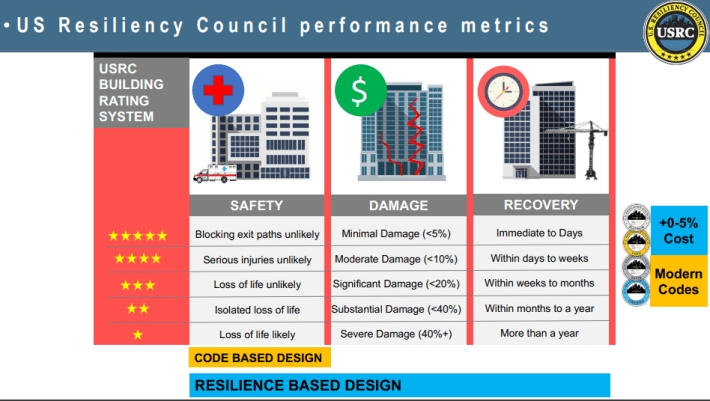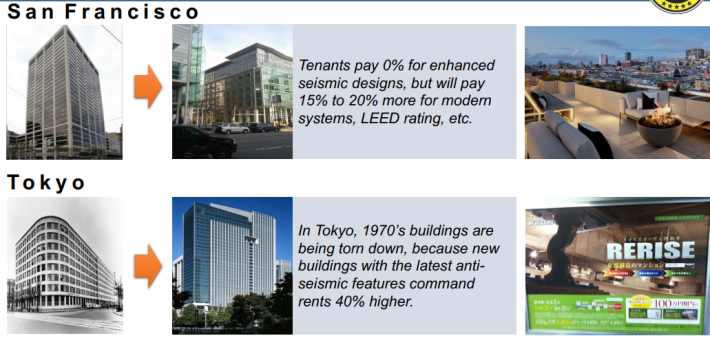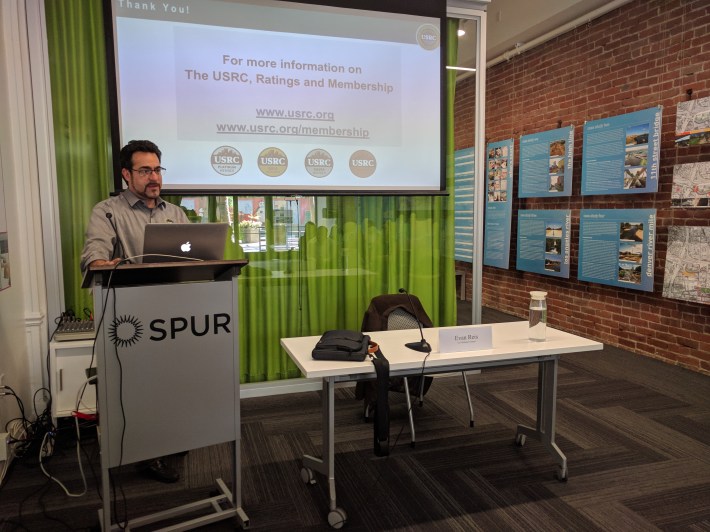Note: GJEL Accident Attorneys regularly sponsors coverage on Streetsblog San Francisco and Streetsblog California. Unless noted in the story, GJEL Accident Attorneys is not consulted for the content or editorial direction of the sponsored content.
When the big one hits, most buildings are likely to survive--in the sense that they're unlikely to pancake and kill their occupants. The bad news: a huge number of them will be damaged beyond repair.
And the problem isn't just old buildings. "Most people think new buildings in California are earthquake proof. They think any building must be at least safe, because why would a government allow unsafe buildings?" said Evan Reis of the U.S. Resiliency Council (USRC), during a presentation at SPUR's San Jose office. The problem, he explained, is builders, homeowners, and to an extent even governments, don't have the tools and aren't economically incentivized to add base isolation and other features that would assure not just that a building won't collapse--but that it's also usable after a major temblor or that it's relatively easy to repair.
The economics do make sense to spend the extra money to make buildings earthquake proof, but we haven't yet figured out how to get that information and the incentives in place. The USRC wants to change that, he explained, by emulating the Leadership in Energy and Environmental Design (LEEDs) certification process.

"LEED Certified" green buildings fetch a premium on the market and can get loan and tax reductions, he said, adding that "It’s okay to have a low impact on the environment, but we want to environment to have a low impact on us too." The idea of his organization is to get buildings spending the extra money to get a high-resiliency certification too, so potential buyers know their investment will still be intact after "the big one."
The stakes couldn't be higher.
"Christchurch, New Zealand had two big earthquakes... these were their big ones, the equivalent of the 1906 earthquake in San Francisco," explained Reis, to illustrate. In a way, it was a testament to their building codes. "Only two buildings collapsed, out of thousands." He said engineers were like "hey, we did our jobs."
But the damage was so severe that half of all buildings had to be torn down eventually. "It left the downtown businesses district a ghost town. If a building has to be torn down, you lose the asset, the work, where you live," he said. "Even if your building survives, now you’re in an area where nobody wants to come."
He also compared economic growth for Nashville and New Orleans after 2005's Hurricane Katrina. Because New Orleans took so long to recover, and using Nashville as a benchmark, it can be estimated that over $100 billion in economic growth failed to materialize because of the lack of resilience in the buildings in New Orleans.
California cities, he said, can't continue to retrofit and build structures that are just good enough that they don't collapse.
He explained that his organization's rating system for buildings is based on well-known earthquake engineering standards. So if a building is properly reinforced, and its base is isolated from severe ground shocks in a way that the building is unlikely to be totaled even in the worst temblor imaginable, it will get a top-tier resilience rating.
They're working with Fannie Mae and other lenders to offer loan discounts for buildings which have these best certifications. It's in the lender's best interests, after all. "In an earthquake that totals the building, the borrower will walk away. So this is designed so lenders will give discounts because there's less risk of default."
It's also seen as an incentive for people buying condos and homes. He showed an example of an add for an apartment building in Tokyo that features a picture of the foundation and its earthquake resistant features. "In San Francisco people buy apartments for the views, in Tokyo they buy them to survive earthquakes."

He said that governments can also offer tax breaks for builders willing to put in the extra investment to make buildings more resilient. In the end, he explained, it only adds about one percent to the overall construction costs; pennies on the dollar compared to the cost of losing the building entirely.
He compared it to buying a car--we know cars are now engineered so that you can crash it into a wall at 25 mph, and survive, he said, but the car will be damaged beyond repair. "So if you paid $80,000 for a new Corvette, would you be willing to pay $800 more so it wouldn't be totaled in a 25 mph crash?"

Of course the answer is "yes." But first you have to know that the option is available. And educating lawmakers, home-buyers, builders, etc. on those economics is exactly what his non-profit is working to achieve. Thus far, the organization has rated some 60 buildings. There are thousands more buildings--and the clock is ticking.
For more information on the work of the U.S. Resiliency Council, or to get your building rated, check out their website.
For more events like these, visit SPUR’s events page.





